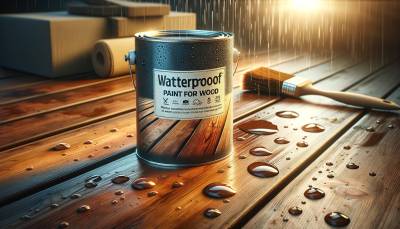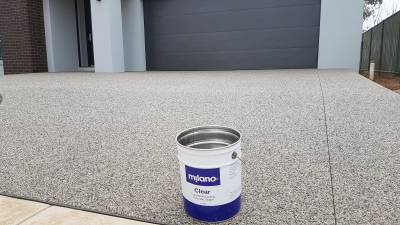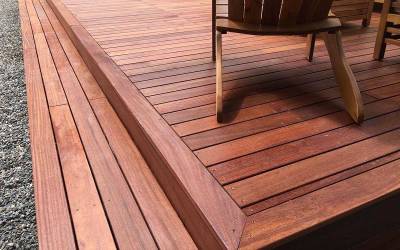If you're a homeowner, you're likely familiar with the constant need to maintain and improve your space. A beautiful wooden fence adds to the aesthetic appeal of a home, but without proper care, it can quickly turn into an eyesore. This is why wood fence stain is so vital. It not only adds a layer of protection to keep your fence looking great, but also enhances the natural look of the wood. In this article, we'll take a deep dive into wood fence stain, it's importance, application process and the best options available in the market.
Understanding Wood Fence Stain
A wood fence often serves as the first line of defence in protecting your home from the elements, so it needs to stay in top shape. Wood fence stain is designed to prevent damage from sun exposure, rain, snow and wood-infesting insects. But it's not just about protection; the right stain can significantly enhance the wood's natural grain and texture, adding to your home's overall aesthetics.
The Importance of Wood Fence Stain
Staining a wooden fence is as much about function as it is about fashion. At first glance, the weathered look of an untreated wooden fence might seem appealing, but over time, this weathering can turn into significant damage. Here's a quick look into why wood fence stain is so important:
- Protection from Weather: Wherever you live, your fence is exposed to weather 24/7. A stain forms a protective layer that guards against damaging UV rays and moisture.
- Insect Damage: Certain types of wood can attract pests. A good stain can act like a repellant, preventing destructive insects like termites from eating away at your fence.
- Enhanced Aesthetics: A thoughtful stain choice can compliment your home's exterior and make a great first impression.
Applying Wood Fence Stain Correctly
Once you've chosen your stain, the next step is application. The process of staining a wooden fence can be time-consuming, but with the right techniques, you'll get it done more efficiently.
Prepare the Surface
Before applying the stain, ensure the wood is clean and dry. You might need to sand or strip the surface if it was previously stained. Pressure washing is a great way to remove dirt and mildew, but remember to let the fence dry completely before moving on to staining.
Selecting the Right Application Tool
There are several tools available for applying stain, including brushes, rollers, and sprayers. The tool you choose should be based on the size of your project and the type of stain you're using.
Stain Application
Now you're ready to stain. Apply a thin, even coat, working in manageable sections. Pay attention to corners and crevices, and make sure to follow the wood grain for the best result.
Best Wood Fence Stain Options
When choosing a stain for your wood fence, consider the color you desire, as well as the desired level of protection. Here are a few top-rated stains to consider:
- Ready Seal: Known for its quality and ease of application, Ready Seal offers a range of colors to suit various preferences.
- Behr Premium: This is a long-lasting and weather-resistant product that offers an impressive range of colors.
- Thompson's WaterSeal: If you're after a natural look, this is a great option. It provides high-level protection for outdoor wood.
Considering these factors when choosing and applying a stain will ensure your fence not only lasts longer but also enhances your property's aesthetic appeal. With the right wood fence stain, you can make your fence shine and stand out against the elements.
Frequently Asked Questions About Wood Fence Stain
What is the purpose of a wood fence stain?
Staining a wood fence serves multiple purposes. First, it enhances the natural grain of the wood, improving the overall aesthetic of your fence. Second, it adds a protective layer that helps safeguard the wood against weather damage, UV rays, molds, and pests. Therefore, applying a wood fence stain not only improves the appearance of your fence, but also extends its longevity.
How do I choose the right stain for my wood fence?
Choosing the right stain involves considering the type of wood your fence is made of, the level of protection needed, and your desired aesthetic outcome. Grain-enhancing stains work well with high-grain woods, while solid stains are better for wood types with less visible grain. For areas with extreme weather conditions, opting for a heavy-duty stain is recommended. Lastly, the color of the stain should complement the surroundings of your fence.
What are the different types of wood fence stains?
There are four main types of wood fence stains. Clear stains preserve the natural color of the wood while providing protection. Transparent stains add a slight tint but allow the wood's texture to show through. Semi-transparent stains give a richer color and still show some wood grain. Solid stains are opaque and cover the grain, but they offer the most protection and color options.
Do I need to prepare my fence before applying stain?
Yes, prepping your fence before staining is crucial for the best results. The fence should be clean and dry. You can use a power washer for best cleaning results and allow the fence to dry for a couple of days before applying the stain. It's also recommended to sand the fence lightly to ensure a smooth surface for the stain to adhere to.
How often should I re-stain my wood fence?
The frequency of re-staining depends on the type of stain used and the local climate. Typically, clear and transparent stains require re-staining every 2-3 years, semi-transparent stains every 3-5 years, and solid stains every 5-7 years. However, if the color starts fading or the wood shows signs of damage, you may need to re-stain earlier.
Is there a best time of year to stain my wood fence?
The best time to stain a wood fence is typically in late spring or early fall when temperatures are moderate and humidity is low. Staining should be done on an overcast day, as the stain may evaporate too quickly in direct sunlight, and heavy dew or rain can interfere with the staining process.
Can I apply wood fence stain over painted surfaces?
Generally, it's not recommended to apply stain over painted surfaces. The stain won't be able to penetrate the wood and won't adhere properly. It is advisable to sand or strip off the old paint before applying stain for the best results.
How do I maintain a stained wood fence?
Maintenance involves regular cleaning to remove dirt and mildew, periodic inspection for signs of damage, and re-staining as needed. By maintaining your stained wood fence, you can extend its lifespan and keep it looking its best.
Is it possible to DIY the process of wood fence staining or should I hire a professional?
If you're comfortable with DIY projects and have the necessary tools, you can stain your wood fence yourself. However, if the fence is large or in poor condition, or if you're unsure about the process, hiring a professional might be a better option.
Pros & Cons of Using Wood Fence Stain
Pros of Using Wood Fence Stain
Enhances the Aesthetic Appeal
The usage of wood fence stain can drastically improve the look of a wooden fence. The stain does not only bring out the rich texture of wood, but it also comes in various shades and colors providing options to match any backyard theme or design.
- The stain can make an old fence look new again.
- The choice of stain color can complement the surrounding landscape, creating a cohesive outdoor aesthetic.
Increases Durability
A quality wood fence stain shields the wood from harsh weather conditions, preventing it from cracking, warping, or fading over time. A durable fence adds value as it lasts longer, reducing the need for replacement or repair.
- Fence stains are particularly effective in climates with extreme weather fluctuations.
- A well-stained fence stands up to rain, wind, and sun, maintaining the overall structural integrity of the fence.
Prevents Infestations
Wood fence stains offer an extra line of defense against insects and mold that can infiltrate and deteriorate your wooden fence.
- Stain penetrates deep into the wood, making it inhospitable to insects like termites.
- It also acts as a sealant, ensuring that moisture doesn’t get trapped in the wood which could lead to mold and mildew.
Cons of Using Wood Fence Stain
Application Process
Applying wood fence stain requires a lot more effort and precision than simply painting a fence. It requires proper technique for even coating and to avoid patches.
- The fence may require preparation, like cleaning and sanding, to ensure the stain adheres effectively.
- Stains are typically runnier than paints, making them more prone to dripping and splattering.
- If not applied properly, stains can result in an uneven or blotchy appearance.
Cost and Regular Re-staining
Good quality wood fence stains can be quite expensive, especially if you have a considerable fence to cover. Also, durability is dependent on the quality and type of stain used, which means you may need to re-stain your fence every 2-3 years.
- Even though a well-stained fence is durable and less susceptible to damage, the costs over time can add up.
- Not only will you have to purchase the stain regularly, but the labor, either time or cost, of the re-staining process should also be acknowledged.
Difficult to Change Color
Once you've stained your fence, you're pretty much locked in with that color until it fully fades or wears away. This can be limiting if you like to change up your backyard design frequently.
- To change color, you may have to strip the previous stain which can be labor-intensive and time-consuming.
- Many stain colors get darker when reapplied, making lighter color changes more difficult.
Less Suitable for Certain Wood Types
Not all types of wood accept wood fence stain well. Some harder woods with tight grain, like cedar or cypress, may reject the stain, leading to uneven results.
- Before you stain, it's vital to ensure that the type of wood you have will respond well to the stain product.
- If your fence is not suitable for staining, you may have to opt for a more expensive type of wood or resort to painting.
Summary
Wood fence stain is an amazing way to enhance the natural beauty of your wooden fence while also offering protection from the elements. When you apply a quality stain, you're not just adding color, you are also prolonging the life of your fence. With a vast array of colors and finishes to choose from, wood fence stain can help you perfectly coordinate your fence with your home's exterior or landscaping.
Remember, the best time to stain a fence is when the wood is dry and ready to absorb the stain effectively. This isn't a task you want to rush, as the benefits of correctly applying wood fence stain are plenty. From curbing wood rot to preventing damage from the sun and severe weather, a stained fence is a well-guarded fence. So, take your time and do it right!
At the end of the day, the weather and time can be a wooden fence's worst enemies. But this doesn't have to be the case for you. With a bit of work, a can of wood fence stain and a free weekend, you can transform and protect your backyard's divider for years to come. Happy staining!
About Grime Busters Pressure Washing
Welcome to Grime Busters Pressure Washing, your number one pressure washing solution in Vancouver, WA! We've dedicated ourselves to providing top-tier service, combining quality work with customer satisfaction. From residential exteriors to commercial properties, our team leaves no stone unturned, making sure all your surfaces are sparkling clean. We pride ourselves on tackling even the toughest grime. Every job is important to us, big or small, attribute that to our unwavering commitment to excellence. We love what we do and we can't wait to show you the Grime Busters difference!
Tags: wood fence stain, outdoor renovation, DIY projects,








